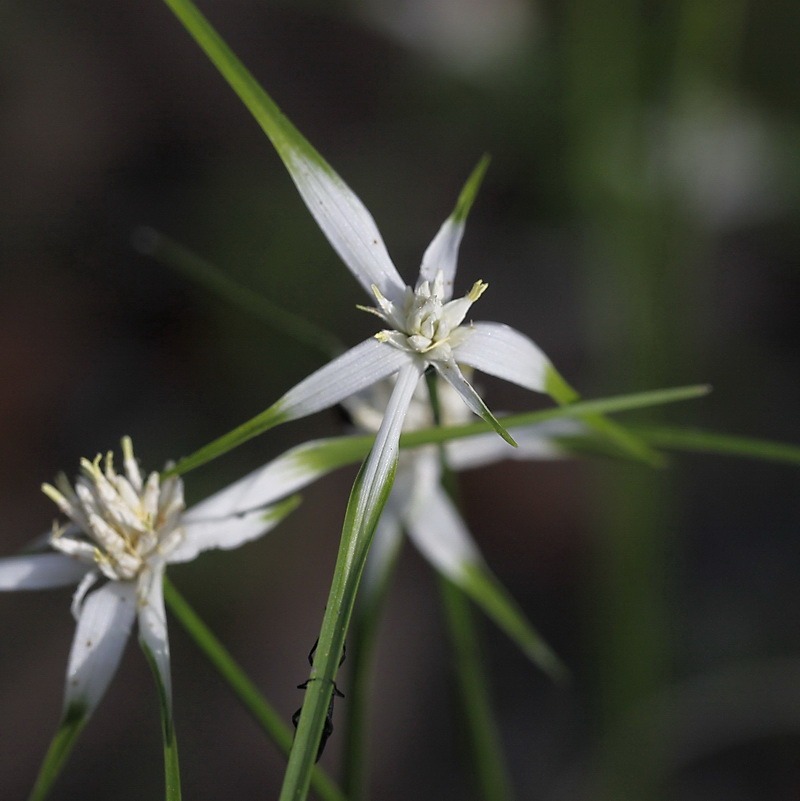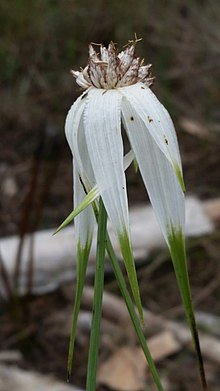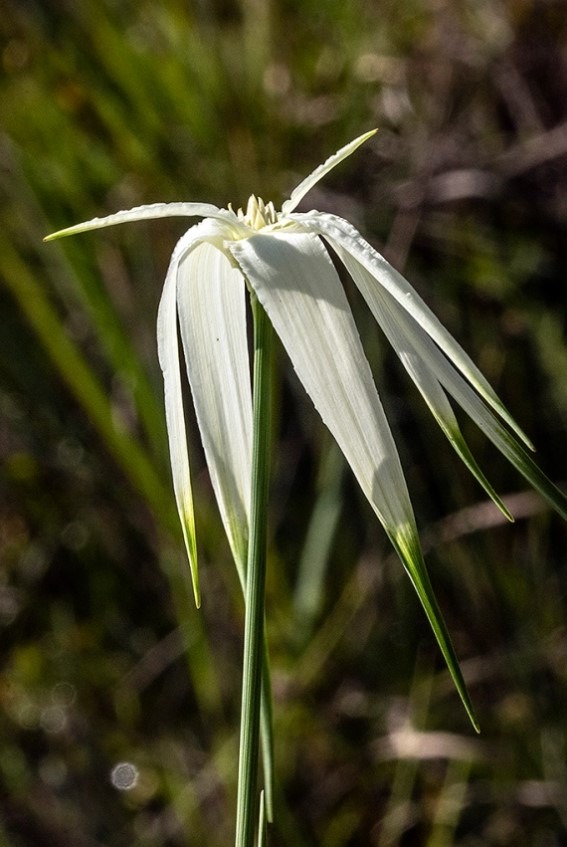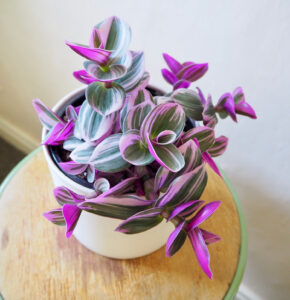
Introduction
Nature’s intricate tapestry is adorned with a myriad of remarkable plants, each possessing its own unique characteristics and ecological significance. Among these botanical marvels lies Rhynchospora colorata, commonly known as White Top Sedge or Starrush Whitetop. This enchanting perennial herbaceous plant, belonging to the Cyperaceae family, captivates the beholder with its delicate white flowers and lush green foliage. Native to the southeastern United States and the Caribbean, Rhynchospora colorata thrives in wetland habitats, serving as a vital component of diverse ecosystems. This essay delves into the fascinating attributes, ecological role, and conservation efforts surrounding the White Top Sedge.
I. Taxonomy and Morphology
Rhynchospora colorata, classified under the order Poales and the family Cyperaceae, showcases a unique blend of beauty and adaptability. This herbaceous perennial boasts slender, erect stems that can reach heights of up to one meter. The stem’s graceful display is crowned with an intricate inflorescence consisting of numerous delicate white flowers, forming a spherical cluster at its apex. Complementing the ethereal blooms, the plant’s narrow, linear leaves create an enchanting contrast against the backdrop of its wetland habitat. The intricate architecture of the White Top Sedge exemplifies nature’s artistry at its finest.

II. Ecological Role
Rhynchospora colorata plays a crucial ecological role in wetland ecosystems, contributing to their health, stability, and biodiversity. As an obligate wetland species, it thrives in marshes, wet prairies, and swamps, where its deep fibrous roots efficiently anchor the soil, preventing erosion and stabilizing the habitat. Moreover, the dense clusters of White Top Sedge create natural microhabitats, providing shelter and foraging opportunities for various organisms.
The ecological significance of Rhynchospora colorata extends beyond its physical structure. The plant’s seeds serve as a food source for several bird species, including waterfowl and seed-eating birds, promoting avian diversity within wetland areas. Additionally, the dense stands of White Top Sedge offer a refuge for invertebrates, amphibians, and small mammals, enhancing overall biodiversity and contributing to the intricate food web of wetland ecosystems.
III. Threats and Conservation Efforts
Despite its ecological importance, Rhynchospora colorata faces several threats that jeopardize its survival. Wetland degradation due to human activities, including drainage for agriculture and urban development, poses a significant risk to the species. Additionally, invasive plant species and altered hydrological regimes disrupt the delicate balance of wetland ecosystems, potentially displacing White Top Sedge and other native flora.
Recognizing the need to protect and conserve Rhynchospora colorata, various conservation initiatives have been implemented. Wetland restoration programs aim to mitigate habitat loss by restoring degraded wetlands and reestablishing favorable hydrological conditions. Such efforts involve controlling invasive species, reintroducing native vegetation, and promoting sustainable land management practices. By restoring and preserving wetland habitats, these conservation projects provide a lifeline for the White Top Sedge and the countless species that depend on them.
Furthermore, public awareness and education campaigns play a crucial role in fostering a sense of environmental stewardship. These initiatives emphasize the importance of wetlands, highlighting the unique attributes and ecological services provided by Rhynchospora colorata and other wetland plants. By encouraging sustainable practices, such as responsible land use and water management, these campaigns empower individuals and communities to contribute to the long-term conservation of White Top Sedge and its fragile ecosystem.
Conclusion
Rhynchospora colorata, the White Top Sedge or Starrush Whitetop, represents a remarkable species that thrives in wetland habitats. Its elegant appearance, ecological significance, and vulnerability to anthropogenic activities underscore the need for conservation efforts. By understanding and appreciating the intricate role played by Rhynchospora colorata in wetland ecosystems, we can forge a path toward sustainable practices that safeguard its survival. Through habitat restoration, invasive species management, and public engagement, we can ensure that future generations will continue to marvel at the beauty of White Top Sedge and the invaluable ecosystems it calls home.

Care Instructions for Starrush Whitetop (Rhynchospora colorata):
Starrush Whitetop, also known as Rhynchospora colorata, is a captivating plant that requires specific care to thrive. Follow these care instructions to ensure the health and beauty of your Starrush Whitetop:
- Light requirements: Starrush Whitetop prefers full sun to partial shade. Place it in an area where it can receive at least six hours of direct sunlight each day. However, it can tolerate some shade, especially in hot climates.
- Watering: Being a wetland species, Starrush Whitetop enjoys consistently moist soil. Ensure that the plant is adequately watered, especially during dry spells or in areas with limited rainfall. However, avoid overwatering, as it may lead to root rot. Check the soil moisture regularly and provide water when the top inch of soil feels dry.
- Soil conditions: Starrush Whitetop thrives in well-draining soil that retains moisture. It prefers acidic to slightly alkaline soil. Before planting, prepare the soil by adding organic matter such as compost or peat moss to improve drainage and fertility.
- Fertilization: Starrush Whitetop generally does not require regular fertilization. However, if you notice poor growth or lack of vigor, you can apply a balanced slow-release fertilizer in spring. Follow the manufacturer’s instructions for application rates.
- Mulching: Apply a layer of organic mulch, such as bark chips or straw, around the base of the plant. Mulching helps retain soil moisture, suppresses weeds, and provides some insulation to the roots.
- Pruning: Starrush Whitetop does not typically require extensive pruning. However, you can trim away any dead or damaged foliage as needed. Pruning can be done in early spring before new growth emerges.
- Winter care: In regions with cold winters, Starrush Whitetop may go dormant or die back. Mulching around the base of the plant can provide some protection during winter months. If needed, consult local gardening resources for additional winter care specific to your region.
- Propagation: Starrush Whitetop can be propagated through division or seed. Division is best done in early spring or fall, separating the plant into smaller clumps and replanting them in suitable locations. Collecting and sowing fresh seeds can also be an option, following specific seed germination guidelines for the species.
By providing appropriate light, moisture, soil conditions, and occasional maintenance, you can enjoy the beauty of Starrush Whitetop in your garden or wetland landscape. Remember to consider the specific requirements of your local climate and adapt these care instructions accordingly.
How To Plant Starrush Whitetop, Rhynchospora colorata
Planting Starrush Whitetop (Rhynchospora colorata) requires attention to specific steps and considerations to ensure successful establishment. Follow these guidelines to plant Starrush Whitetop effectively:

- Selecting the planting location: Choose a suitable spot that mimics the natural wetland habitat where Starrush Whitetop thrives. It should receive full sun to partial shade, with adequate moisture. Consider planting it in marshy areas, wet prairies, or near the edges of ponds or streams.
- Preparing the soil: Starrush Whitetop prefers well-draining soil that retains moisture. Before planting, prepare the soil by removing any weeds or debris. Incorporate organic matter such as compost or peat moss to improve soil structure, fertility, and moisture retention.
- Planting depth: Dig a hole that is slightly wider and deeper than the plant’s root ball. Place the Starrush Whitetop into the hole, ensuring that the top of the root ball is level with or slightly above the soil surface. This plant does well with its roots submerged in water or in consistently moist soil.
- Backfilling and firming the soil: Gently backfill the hole with the soil mixture, ensuring that the roots are well-covered but not excessively compacted. Lightly press down the soil around the plant to remove any air pockets.
- Watering: Immediately after planting, thoroughly water the Starrush Whitetop to settle the soil and ensure good root-to-soil contact. Maintain consistent moisture in the soil during the establishment period. Water regularly, especially during dry periods or if rainfall is insufficient.
- Mulching: Apply a layer of organic mulch, such as bark chips or straw, around the base of the plant. Mulching helps retain moisture, suppresses weed growth, and regulates soil temperature. Leave a small gap around the stem to prevent excess moisture buildup and potential rotting.
- Maintenance and care: Monitor the plant regularly and ensure it receives adequate water. Remove any weeds that may compete with the Starrush Whitetop for nutrients and water. Avoid overwatering, as it can lead to root rot. Prune any dead or damaged foliage as necessary.
- Protection during extreme conditions: If your region experiences cold winters, provide protection for Starrush Whitetop. Apply a layer of mulch around the base of the plant to insulate the roots. Consult local gardening resources for additional winter care specific to your region.
By following these planting guidelines and providing appropriate care, Starrush Whitetop can flourish and contribute to the beauty and ecological value of wetland habitats.


